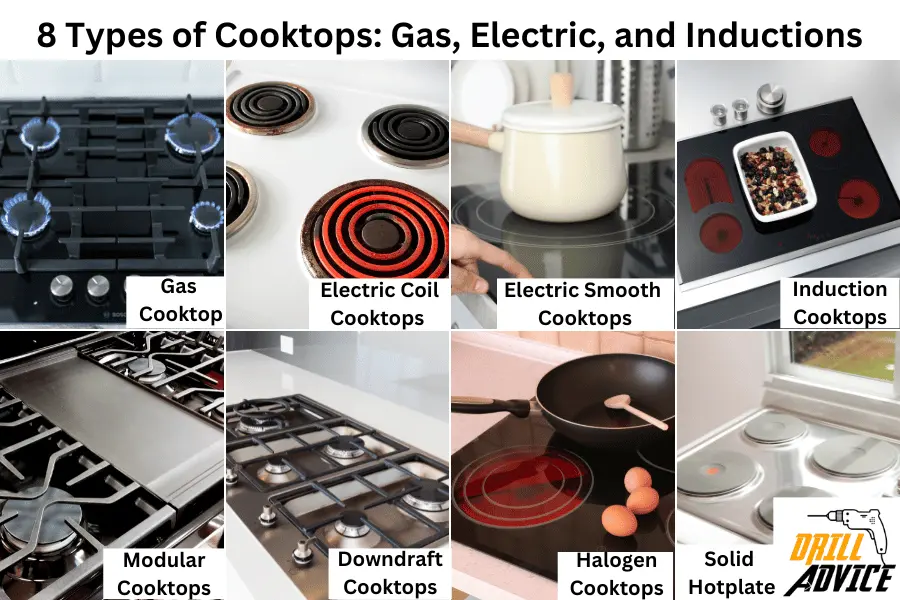
The cooktop is an open flat surface in the kitchen that is used for cooking. Cooktops can be categorized into 3 main types according to their power source. Those categories are gas cooktops, electric cooktops and induction cooktops. A gas cooktop is powered by natural gas or propane. The electric cooktop is operated by electricity, and the induction cooktop is operated by electricity. But induction cooktops generate heat using magnets.
These are the 8 types of cooktops that you can use. Those are gas cooktops, electric coil cooktops, electric smooth cooktops, induction cooktops, modular cooktops, downdraft cooktops, halogen cooktops, and solid hotplates.
Before choosing a cooktop, you should consider the power source of the cooktop. Mainly cooktops are mainly 3 power sources such as gas, electric, and induction cooktop. Then you should consider the efficiency of the cooktop. The most efficient cooktop is the induction cooktop. Then you should consider the cost of the cooktop. Starting cost and long time cost are two types. Gas cooktops are cheap for the starting cost, but it is expensive considering the long time usage.
The cooktop should be easily maintained, repaired and cleaned during its usage when you choose; you should consider this also. You should consider the environmental effect of the cooktop. Gas cooktops emit greenhouse gases during its service life. But electric cooktops do not emit these harmful gases. When considering the environmental effect, electric cooktops are better. Most of the cooktops have been designed smartly using new technology. Hence before choosing a cooktop, you should know the user experience of the cooktop.
What Should Consider Before Choose a Cooktop?

Before choosing a cooktop, you should consider these 6 facts such as power source of the cooktop, efficiency, cost, maintenance, repair, cleaning, environmental effect, and user experience of the cooktop.
1. Power Source of the Cooktop
Cooktops can use different power sources to cook your food. Cooktops are mainly three types according to power source. Those are gas, electric, and induction. Gas cooktops use natural gas or propane to create flames that cook your food. Electric cooktops use electricity to heat up coils or plates. Induction cooktops use special technology that creates heat in the cookware itself using magnets. The power source is important because it affects how fast your food cooks and how much energy is used.
2. Efficiency of the Cooktop
The efficiency of the cooktop is how well the cooktop turns the electric energy they use into heat for cooking. An efficient cooktop will heat up quickly and cook your food easily. Induction cooktops are usually very efficient because they heat up fast and waste less energy.
3. Cost of the Cooktop
When you’re thinking about the cost of a cooktop, there are two parts to consider: the starting cost and the long-term cost for using it.
Electric cooktops usually have a lower starting cost, but they can be more expensive to run over time because electricity costs can add up.
Gas cooktops might have a higher starting cost, but they can be cheaper to run if you have access to affordable gas.
Induction cooktops are efficient and can have a mid-range starting cost, and their long-term cost depends on your electricity rates.
4. Maintenance, Repair and Cleaning of the Cooktop
No matter which cooktop you choose, there will be some maintenance involved. Electric cooktops may need regular cleaning to avoid burnt-on food. Gas cooktops need cleaning around the burners and grates. Induction cooktops are easier to clean because they don’t get as hot. If something goes wrong, you might need repairs. Choosing a cooktop with a warranty can help cover repairs if they’re needed.
5. Environmental Effect of the Cooktop
Cooktops can have an impact on the environment due to emissions and pollutants. Gas cooktops can release gases like carbon monoxide, while electric cooktops might rely on power sources that generate emissions. Induction cooktops are often considered more environmentally friendly because they produce fewer emissions and pollutants.
6. User Experience of the Cooktop
Using a cooktop should be easy and convenient. Gas cooktops have knobs you turn to control the flame, electric cooktops have touch controls for adjusting the temperature, and induction cooktops need special cookware. Some cooktops also come with smart technology that lets you control them using your smartphone.
Read More About
- What to Know About Kitchen Backsplash? Size, Materials, and Recommendations
- 13 Types of Kitchen Faucets: Factors, Functions, Sink Types and Maintenance
- 18 Best Kitchen Countertop Materials: Budget, Resistance, Maintenance, and Aesthetic Appeal
What are the 8 Types of Cooktops?
1. Gas Cooktop

Gas cooktops use natural gas or propane as their primary power source. They are popular for their precise temperature control and quick heat adjustments.
- Power Source – The main power source of the gas cooktop is natural gas or propane.
- Efficiency – Gas Cooktops are less efficient. Gas cooktops generate heat instantly.. The flame provides direct heat to your pots and pans. But not all of the heat from the flame reaches the cookware; some can be wasted around the sides.
- Cost for Power – Generally, gas cooktops tend to be more cost-effective in areas where natural gas is affordable. However, compared to induction cooktops, which are highly efficient, you might use more energy (and hence money) with gas.
- Maintenance, Repair and Cleaning of Gas Cooktop
- Cleaning: Gas cooktops should be cleaned regularly to remove food spills and prevent clogs in the burners.
- Maintenance: Ensure proper gas flow and occasionally check for gas leaks.
- Repair: Issues like a malfunctioning igniter or clogged burners may need professional attention.
- Environmental Effect – Gas cooktops emit small amounts of carbon monoxide and other gases. Therefore your kitchen should be well-ventilated.
- User Experience – Gas cooktops come with knobs to control the flame level. Some modern ones may have electronic ignition and safety features. Learning to adjust the flame will give you precise control over your cooking.
2. Electric Coil Cooktops

Electric coil cooktops have spiral-shaped burners on the surface that heat up when electricity passes through them. They’re often seen in older kitchens and are a traditional type of electric cooktop.
- Power Source – The main power source for electric coil cooktops is electricity. You plug it into an electric outlet, and you’re good to go!
- Efficiency – Electric coil cooktops take a little time to heat up and cool down. They’re not as efficient as induction cooktops because some heat is lost to the surrounding air, but they do their job.
- Cost
- Starting Costs of electric coil cooktops are generally less expensive than other types, making them a budget-friendly option.
- Long-Time Using Cost of electric coil cooktops are slightly more expensive to operate than gas or induction cooktops because of the electricity they use. However, your electric bill will tell you more about how much it affects your costs.
- Maintenance and Repair
- Cleaning: After use, and once it’s cooled, wipe the coils with a damp cloth to remove spills. Using a mild cleaner can help with stubborn spots.
- Maintenance: Occasionally check that the coils are sitting flat for even cooking.
- Repair: Over time, the coils may wear out and need replacement.
- Environmental Effect – Electric coil cooktops don’t produce direct emissions like gas cooktops. But the environmental impact can come from how the electricity is generated, like from coal or renewable sources.
- User Experience – Electric coil cooktops usually have knobs to adjust the heat. Turn the knob to change the heat level. There’s no fancy tech here, but it’s straightforward and user-friendly.
3. Electric Smooth Cooktops

This type of cooktop has a smooth surface, usually made of ceramic or glass, which heats up using electric elements underneath. It looks sleek and modern!
- Power Source – Electricity powers the electric smooth cooktop. You’ll need an appropriate electric connection in your kitchen for it.
- Efficiency – Electric smooth cooktops heat up fairly quickly and provide even heat distribution. Some heat might be lost to the surroundings, but they’re generally more efficient than their coil counterparts.
- Cost
- Starting cost: of the electric smooth cooktops can be a bit higher than electric coil cooktops due to their sleek design and advanced features.
- Long-Time using cost of electric smooth cooktops are cheap because They can be more energy-efficient than coil cooktops, which might save you some money in the long run on electricity bills.
- Maintenance and Repair
- Cleaning: Wipe the surface with a damp cloth or special ceramic cleaner to remove spills and avoid scratches. It’s easier to clean than coil cooktops because of the smooth surface!
- Maintenance: Make sure no heavy objects fall on it to prevent cracking.
- Repair: If the surface gets damaged or an element stops working, you might need a professional to fix it.
- Environmental Effect – Electric smooth cooktops don’t produce any direct emissions in your home. But remember, the environmental impact might come from the way your electricity is produced, like if it’s from fossil fuels or renewable energy sources.
- User Experience – These cooktops come with touch controls or knobs. You’ll adjust the heat by tapping the controls or turning the knobs. Some even have cool features like timers or special heat settings for specific dishes.
4. Induction Cooktops
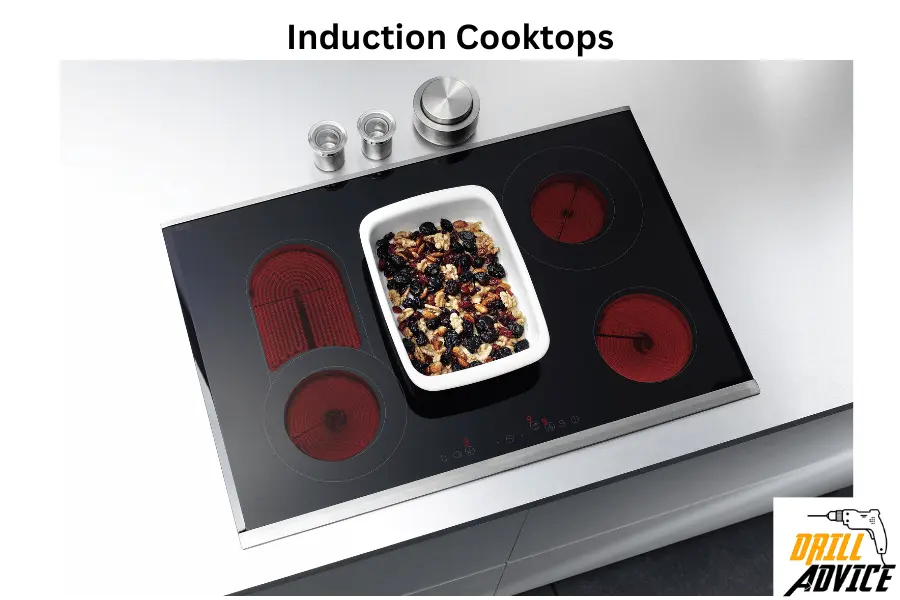
An induction cooktop uses magnetic fields to heat up pots and pans. Unlike traditional cooktops, the cooktop itself doesn’t get hot. Instead, the heat is directly transferred to your cookware!
- Power Source – Induction cooktops need an electric outlet.
- Efficiency – Super efficient! Induction cooktops heat your cookware almost instantly, which means less waiting time. And since the heat goes directly into the cookware, there’s minimal heat loss.
- Cost
- Starting cost of Induction cooktops tends to be more expensive upfront than electric or gas cooktops.
- Long time using the cost of induction cooktops are cheap due to its higher efficiency. It can save you money on your electric bill in the long run.
- Maintenance and Repair
- Cleaning: Super easy. Just wipe the smooth surface with a damp cloth.
- Maintenance: Keep it free from scratches and use compatible cookware.
- Repair: If it stops working, you might need a professional. But these cooktops are generally quite reliable.
- Environmental Effect – Induction cooktops are energy efficient, which means less waste. But like all electric appliances, their environmental friendliness also depends on how your electricity is generated.
- User Experience
- Controls: Most induction cooktops have touch controls. You can easily adjust the heat level with a tap.
- Technology: Some come with safety features, like detecting if there’s no pot on the burner and turning off automatically. And remember, only magnetic pots and pans (like those made of iron or steel) will work.
5. Modular Cooktops

Modular cooktops are like the customizable puzzle pieces of the kitchen. Instead of having one fixed cooktop surface, you get sections or modules that can have different types of burners or features.
- Power Source – Modular cooktops can use various power sources depending on the module, including:
- Gas: For those who prefer the control of a flame.
- Electric: Traditional coil or smooth electric surfaces.
- Induction: Using magnetic fields for efficient cooking.
- Efficiency – The efficiency of modular cooktops depends on the specific module you’re using. For instance, induction modules will heat up faster and waste less energy than traditional electric coils.
- Cost
- Starting cost of modular cooktops can be more expensive upfront due to their flexibility and the technology involved.
- Long-time using cost for modular cooktops will vary depending on the modules you frequently use. For example, using induction modules may save more energy in the long run.
- Maintenance and Repair
- Cleaning: Because of the separate modules, cleaning can be easier, especially if you can remove a section and clean around it.
- Maintenance: Ensure the connections between modules are secure and clean.
- Repair: One advantage of modular cooktops is that if one module has an issue, you can replace just that module instead of the whole cooktop.
- Environmental Effect – The efficiency depends on the modules you choose. Induction modules, for instance, are more energy-efficient, while the environmental impact of gas modules will depend on your gas source.
- User Experience
- Controls: Modular cooktops often come with intuitive controls, either as knobs or touch controls, depending on the design.
- Flexibility: You can customize your cooking surface based on your needs. Want a grill module in the middle? Or an extra induction burner? With modular, you can make it happen.
6. Downdraft Cooktops
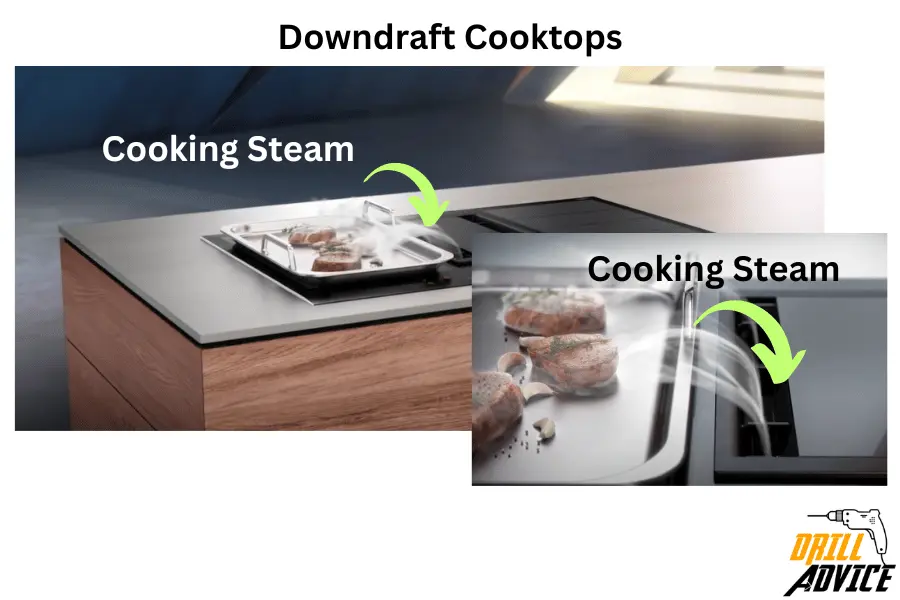
Downdraft cooktops are special because they have a built-in ventilation system. Instead of a hood above the cooktop, they pull the smoke and steam downward, right at the source.
- Power Source – Downdraft cooktops can be:
- Gas: Using natural gas or propane.
- Electric: Traditional coil, smooth electric, or even induction.
- The main difference is the downdraft ventilation, not the power source.
- Efficiency – They’re efficient at removing steam and odors because the ventilation is right there on the cooktop. However, the efficiency in cooking (like heating up pots) will depend on whether it’s gas, electric coil, smooth electric, or induction.
- Cost
- Starting cost of Downdraft cooktops can be pricier than regular cooktops because of the integrated ventilation system.
- Long Time using cost of downdraft cooktop can vary with the power source. For instance, gas might be cheaper than electricity in some areas.
- Maintenance and Repair
- Cleaning: The cooktop surface can be wiped down like other cooktops. The ventilation grills might need regular cleaning to remove trapped grease and particles.
- Maintenance: Ensure the downdraft system remains unblocked and functioning properly.
- Repair: If the ventilation system malfunctions, you might need specialized service. But generally, the cooking element (like gas or electric) can be serviced like any other cooktop.
- Environmental Effect – It depends on the power source. Gas has emissions, while the environmental footprint of electric types depends on your electricity source. However, downdraft cooktops can be better for indoor air quality because they remove smoke and odors efficiently.
- User Experience
- Controls: Most downdraft cooktops come with easy-to-use knobs or touch controls for both cooking and ventilation.
- Ventilation: One main benefit is that you don’t need an overhead hood, giving a more open and spacious feel to the kitchen.
7. Halogen Cooktops
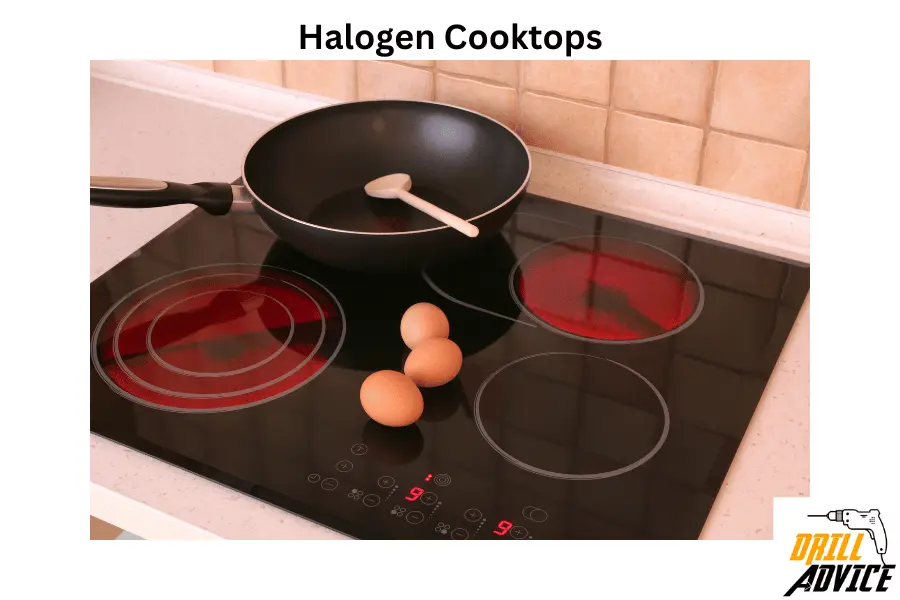
Halogen cooktops use halogen bulbs beneath a smooth, ceramic glass surface to produce heat. When turned on, the bulbs glow bright, heating your pot or pan above.
- Power Source – The halogen bulbs in the cooktop are powered by electricity. You can use it in domestic power supply.
- Efficiency – Halogen cooktops heat up quickly, giving you faster cooking times compared to some other electric cooktops. While they heat up quickly, they also lose heat fairly rapidly when turned off. But, the ceramic glass surface retains and evenly distributes the heat.
- Cost
- Starting cost of halogen cooktops can be a bit more expensive than basic electric coil cooktops but are usually less pricey than induction cooktops.
- Long-Time using cost is minimal due to their quick heat-up time but might not be as energy-saving as induction cooktops.
- Maintenance and Repair
- Cleaning: The smooth ceramic glass surface is a breeze to clean. Just wipe with a damp cloth or use a ceramic cleaner.
- Maintenance: Keep sharp and heavy objects away to prevent scratches or cracks on the glass surface.
- Repair: If a bulb goes out or the glass surface gets damaged, you’d likely need a professional’s help.
- Environmental Effect – Given they run on electricity, their environmental footprint will depend on how your electricity is generated. No direct emissions are produced by the cooktop itself, but power plants might.
- User Experience
- Controls: Typically, halogen cooktops come with knobs or touch controls. Adjusting the temperature is as simple as dimming a light.
- Visual: One unique aspect is you can see the bright glow of the halogen bulbs, which some people find fascinating!
8. Solid Hotplate
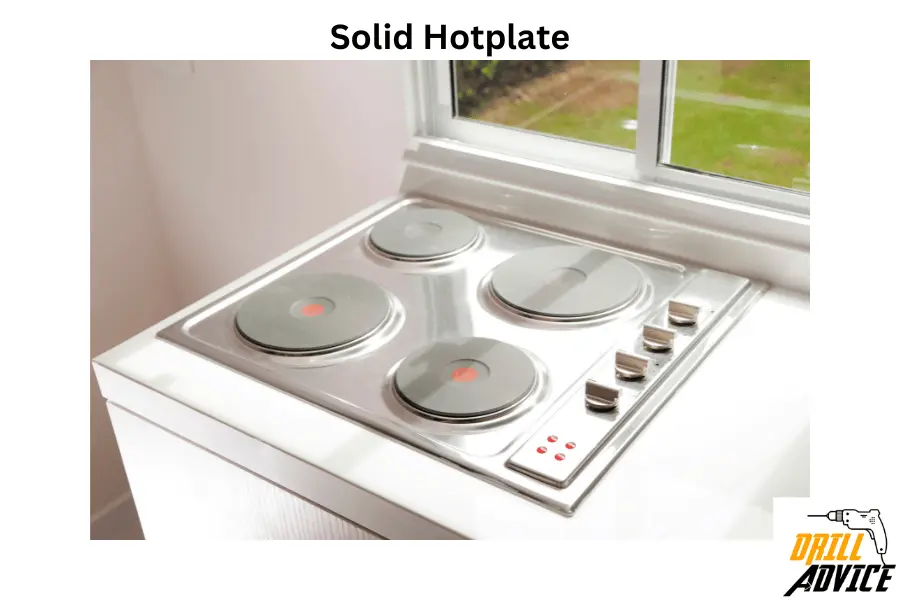
Solid hotplate cooktops are made of solid iron or a similar metal. When you turn them on, they heat up evenly across the plate, providing a stable cooking surface.
- Power Source – Solid hotplate cooktops are electric, so you’d connect them to your standard kitchen power supply.
- Efficiency – Solid hotplate cooktops take a bit longer to heat up compared to other electric cooktop types. Once hot, they retain their heat for a while, even after being turned off. This can be both a pro (keeping food warm) and a con (may use more electricity if you forget to turn them off early).
- Cost
- Starting Cost: Generally, solid hotplate cooktops are among the more affordable electric cooktop options.
- Long Time Using Cost: They may use more electricity over time because they retain heat longer and take longer to heat up.
- Maintenance and Repair
- Cleaning: The solid plate is relatively easy to clean with a damp cloth, but it’s essential to wait until it’s completely cooled down.
- Maintenance: With fewer parts and no open burners, they’re low maintenance.
- Repair: They’re durable, but if something goes wrong, a technician might be needed.
- Environmental Effect – As with most electric cooktops, their environmental impact depends on the source of your electricity. Using green energy sources would make this cooktop more eco-friendly.
- User Experience
- Controls: Typically, they come with simple knobs to adjust the temperature.
- Safety: The surface remains hot for a while after being turned off, so caution is needed to avoid burns.
